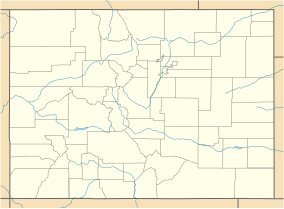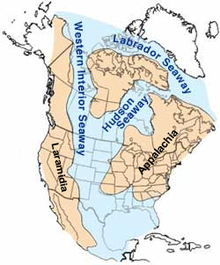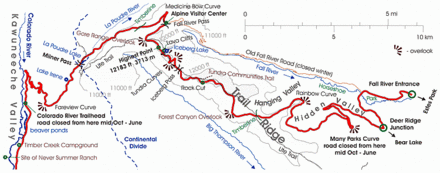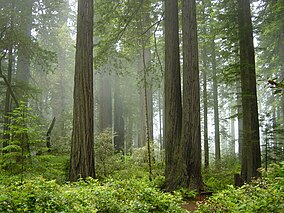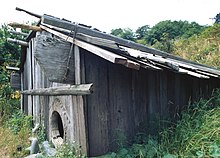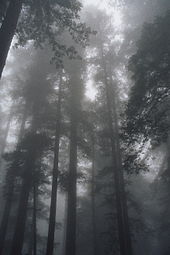| Rocky Mountain National Park | |
|---|---|
IUCN category II (national park)
| |
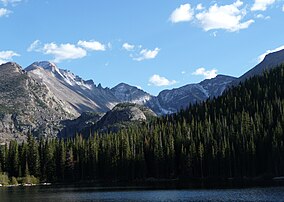
View from Bear Lake in Rocky Mountain National Park
| |
| Location | Larimer / Grand / Boulder counties, Colorado, United States |
| Nearest city | Estes Park and Grand Lake, Colorado |
| Coordinates | 40°20′00″N 105°42′32″WCoordinates: 40°20′00″N 105°42′32″W |
| Area | 265,461 acres (1,074.28 km2) |
| Established | January 26, 1915 |
| Visitors | 4,590,493 (in 2018) |
| Governing body | National Park Service |
| Website | Official website |
Rocky Mountain National Park is an American national park located approximately 76 mi (122 km) northwest of Denver International Airport in north-central Colorado, within the Front Range of the Rocky Mountains. The park is situated between the towns of Estes Park to the east and Grand Lake to the west. The eastern and western slopes of the Continental Divide run directly through the center of the park with the headwaters of the Colorado River located in the park's northwestern region. The main features of the park include mountains, alpine lakes and a wide variety of wildlife within various climates and environments, from wooded forests to mountain tundra.
The Rocky Mountain National Park Act was signed by President Woodrow Wilson on January 26, 1915, establishing the park boundaries and protecting the area for future generations. The Civilian Conservation Corps built the main automobile route, Trail Ridge Road, in the 1930s. In 1976, UNESCO designated the park as one of the first World Biosphere Reserves. In 2018, more than 4.5 million recreational visitors entered the park. The park is one of the most visited in the National Park System, ranking as the third most visited national park in 2015. In 2019, the park saw record attendance yet again with 4,678,804 visitors, a 44% increase since 2012.
The park has a total of five visitor centers with park headquarters located at the Beaver Meadows Visitor Center—a National Historic Landmark designed by the Frank Lloyd Wright School of Architecture at Taliesin West. National Forest lands surround the park including Roosevelt National Forest to the north and east, Routt National Forest to the north and west, and Arapaho National Forest to the west and south, with the Indian Peaks Wilderness area located directly south of the park.
History
Location of the Rocky Mountains
The history of Rocky Mountain National Park began when Paleo-Indians traveled along what is now Trail Ridge Road to hunt and forage for food. Ute and Arapaho people subsequently hunted and camped in the area. In 1820, the Long Expedition, led by Stephen H. Long for whom Longs Peak was named, approached the Rockies via the Platte River. Settlers began arriving in the mid-1800s, displacing the Native Americans who mostly left the area voluntarily by 1860, while others were removed to reservations by 1878.
Lulu City, Dutchtown, and Gaskill in the Never Summer Mountains were established in the 1870s when prospectors came in search of gold and silver. The boom ended by 1883 with miners deserting their claims. The railroad reached Lyons, Colorado in 1881 and the Big Thompson Canyon Road—a section of U.S. Route 34 from Loveland to Estes Park—was completed in 1904.
The 1920s saw a boom in building lodges and roads in the park,
culminating with the construction of Trail Ridge Road to Fall River Pass
between 1929 and 1932, then to Grand Lake by 1938.
Prominent individuals in the effort to create a national park included Enos Mills from the Estes Park area, James Grafton Rogers from Denver, and J. Horace McFarland of Pennsylvania.[25] The national park was established on January 26, 1915.
Geography
Rocky Mountain National Park encompasses 265,461 acres (414.78 sq mi; 1,074.28 km2) of federal land, with an additional 253,059 acres (395.40 sq mi; 1,024.09 km2) of U.S. Forest Service wilderness adjoining the park boundaries. The Continental Divide runs generally north–south through the center of the park, with rivers and streams on the western side of the divide flowing toward the Pacific Ocean while those on the eastern side flow toward the Atlantic.
A geographical anomaly is found along the slopes of the Never Summer Mountains where the Continental Divide forms a horseshoe–shaped
bend for about 6 miles (9.7 km), heading from south–to–north but then
curving sharply southward and westward out of the park. The sharp bend results in streams on the eastern slopes of the range joining the headwaters of the Colorado River that flow south and west, eventually reaching the Pacific. Meanwhile, streams on the western slopes join rivers that flow north and then east and south, eventually reaching the Atlantic.
View from Many Parks Curve on Trail Ridge Road. The "parks" in the Rockies are meadows that formed when glacial lakes drained.
The headwaters of the Colorado River are located in the park's northwestern region. The park contains approximately 450 miles (724 km) of rivers and streams, 350 miles (563 km) of trails, and 150 lakes.
Rocky Mountain National Park is one of the highest national parks
in the nation, with elevations from 7,860 to 14,259 feet (2,396 to
4,346 m), the highest point of which is Longs Peak. Trail Ridge Road is the highest paved through-road in the country, with a peak elevation of 12,183 feet (3,713 m). Sixty mountain peaks over 12,000 feet (3,658 m) high provide scenic vistas. On the north side of the park, the Mummy Range contains a number of thirteener peaks, including Hagues Peak, Mummy Mountain, Fairchild Mountain, Ypsilon Mountain, and Mount Chiquita. Several small glaciers and permanent snowfields are found in the high mountain cirques.
There are five regions, or geographical zones, within the park.
Region 1: Moose and big meadows
Region 1 is known for moose and big meadows and is located on the west, or Grand Lake, side of the Continental Divide. Thirty miles of the Continental Divide National Scenic Trail loop through the park and pass through alpine tundra and scenery.
Bull elk in a meadow near the headwaters of the Colorado River
The Big Meadows area with its grasses and wildflowers can be reached
via the Onahu, Tonahutu, or Green Mountain trail. Other scenic areas
include Long Meadows and the Kawuneeche Valley (Coyote Valley) of the upper Colorado River which is a good place for birdwatching, as well as snowshoeing and cross-country skiing in winter. The valley trail loops through Kawuneeche Valley which contained as many as 39 mines, though less than 20 of those have archived records and archeological remains. LuLu City is the site of an abandoned silver mining town of the early 1880s located along the Colorado River Trail. According to a 1985 report prepared for the NRHP, there were only three cabin ruins remaining along with remnants of six other buildings.
Baker Pass crosses the Continental Divide through the Never Summer Mountains and into the Michigan River drainage to the west of Mount Nimbus—a drainage that feeds streams and rivers that drain into the Gulf of Mexico. Other mountain passes are La Poudre Pass
and Thunder Pass, which was once used by stage coaches and is a route
to Michigan Lakes. Little Yellowstone has geological features similar to
the Grand Canyon of the Yellowstone.
The Green Mountain trail once was a wagon road used to haul hay from
Big Meadows. Flattop Mountain, which can be accessed from the eastern
and western sides of the park, is near Green Mountain. Shadow Mountain Lookout—a wildfire observation tower—is on the National Register of Historic Places. Paradise Park Natural Area is an essentially hidden and protected wild area with no maintained trails penetrating it.
Skeleton Gulch, Cascade Falls, North Inlet Falls, Granite Falls,
and Adams Falls are found in the west side of the park. The west side
lakes include Bowen Lake, Lake Verna, Lake of the Clouds, Haynach Lakes,
Timber Lake, Lone Pine Lake, Lake Nanita, and Lake Nokoni.
Region 2: Alpine region
The alpine tundra of Rocky Mountain National Park taken along the Tundra Communities Trail at approximately 12,000 feet.
Region 2 is the alpine region of the park with accessible tundra
trails at high elevations—an area known for its spectacular vistas.
Within the region are Mount Ida, with tundra slopes and a wide-open
view of the Continental Divide, and Specimen Mountain, which has a steep
trail and the opportunity to view bighorn sheep and marmots. Forest
Canyon Pass is near the top of the Old Ute Trail that once linked
villages across the Continental Divide.
Chapin Pass trail traverses a dense forest to beautiful views of
the Chapin Creek valley, proceeding onward above timberline to the
western flank of Mount Chapin. Tundra Communities Trail, accessible from
Trail Ridge Road, is a hike offering tundra views and alpine
wildflowers. Other trails are Tombstone Ridge and Ute Trail, which
starts at the tundra and is mostly downhill from Ute Crossing to Upper Beaver Meadows,
with one backcountry camping site. Cache La Poudre River trail begins
north of Poudre Lake on the west side of the valley near Milner Pass and
heads downward toward the Mummy Pass trail junction. Lake Irene is a
recreation and picnic area.
Region 3: Wilderness
Region 3, known for wilderness escape, is in the northern part of the park and is accessed from the Estes Park area.
Ypsilon Mountain from the Ypsilon Lake Trail
The Mummy Range
is a short mountain range in the north of the park. The Mummies tend to
be gentler and more forested than the other peaks in the park, though
some slopes are rugged and heavily glaciated, particularly around Ypsilon Mountain and Mummy Mountain.
Bridal Veil Falls is a scenic point and trail accessible from the Cow
Creek trailhead, at the Continental Divide Research Center.
West Creek Falls and Chasm Falls, near Old Fall River Road, are also in
this region. The Alluvial Fan trail leads to a bridge over the river
that had been the site of the Lawn Lake Flood.
Lumpy Ridge Trail leads to Paul Bunyan's Boot at about 1.5 mi
(2.4 km) from the trailhead, then Gem Lake, and a further 2.2 mi
(3.5 km) to Balanced Rock.
Black Canyon Trail intersects Cow Creek Trail, forming part of the Gem
Lake loop which goes through the old McGregor Ranch valley, passing
Lumpy Ridge rock formations, with a loop hike that goes into the McGraw
Ranch valley.
Cow Creek Trail follows Cow Creek, with its many beaver ponds,
extending past the Bridal Falls turnoff as the Dark Mountain trail, then
joining the Black Canyon trail to intersect the Lawn Lake trail shortly
below the lake. North Boundary Trail connects to the Lost Lake trail system. North Fork Trail begins outside of the park in the Comanche Peak Wilderness before reaching the park boundary and ending at Lost Lake. Stormy Peaks Trail connects Colorado State University's Pingree Park campus in the Comanche Peak Wilderness and the North Fork Trail inside the park.
Beaver Mountain Loop, also used by horseback riders, passes
through forests and meadows, crosses Beaver Brook and several
aspen-filled drainages, and has a great view of Longs Peak.
Deer Mountain Trail gives a 360 degree view of eastern part of the
park. The summit plateau of Deer Mountain offers expansive views of the
Continental Divide. During the winter, the lower trail generally has
little snow, though packed and drifted snow are to be expected on the
switchbacks. Snow cover on the summit may be three to five feet deep,
requiring the use of snowshoes or skis.
The trail to Lake Estes in Estes Park meanders through a bird
sanctuary, beside a golf course, along the Big Thompson River and Fish
Creek, through the lakeside picnic area and along the lakeshore. The
trail is used by birdwatchers, bikers and hikers.
Lawn Lake Trail climbs to Lawn Lake and Crystal Lake, one of the
parks deepest lakes, in the alpine ecosystem and along the course of the
Roaring River. The river shows the massive damage caused by a dam
failure in 1982 that claimed the lives of three campers. The trail is a
strenuous snowshoe hike in the winter.
Ypsilon Lake Trail leads to its namesake as well as Chipmunk Lake, with
views of Longs Peak, while traversing pine forests with grouseberry and
bearberry bushes. The trail also offers views of the canyon gouged out
by rampaging water that broke loose from Lawn Lake Dam in 1982. Visible
is the south face of Ypsilon Mountain, with its Y shaped gash rising
sharply from the shoreline.
Gem Lake is high among the rounded granite domes of Lumpy Ridge.
Untouched by glaciation, this outcrop of 1.8 billion-year-old granite
has been sculpted by wind and chemical erosion into a backbone-like
ridge. Pillars, potholes, and balanced rocks are found around the
midpoint of the trail, along with views of the Estes Valley and
Continental Divide. Potts Puddle trail is accessible from the Black Canyon trail.
Region 4: Heart of the park
Bear Lake
Region 4 is the heart of the park with easy road and trail access,
great views, and lake hikes including the most popular trails.
Flattop Mountain is a tundra hike and the easiest hike to the
Continental Divide in the park. Crossing over Flattop Mountain, the hike
to Hallett Peak passes through three climate zones, traversing the
ridge that supports Tyndall Glacier and finally ascending to the summit of Hallett Peak.
Bear Lake is a high-elevation lake in a spruce and fir forest at the base of Hallett Peak and Flattop Mountain. Bierstadt Lake sits atop a lateral moraine
named Bierstadt Moraine, and drains into Mill Creek. There are several
trails that lead to Bierstadt Lake through groves of aspens and
lodgepole pines.
North of Bierstadt Moraine is Hollowell Park, a large and marshy meadow
along Mill Creek. The Hollowell Park trail runs along Steep Mountain's
south side. Ranches, lumber and sawmill enterprises operated in
Hollowell Park into the early 1900s.
Glacial Basin was the site of a resort run by Abner and Alberta Sprague, after whom Sprague Lake is named. The lake is a shallow body of water that was created when the Spragues dammed Boulder Brook to create a fish pond.
Sprague Lake is a popular place for birdwatching, hiking and viewing
the mountain peaks, along with camping at the Glacier Basin campground.
Emerald Lake and Hallett Peak
Dream Lake is one of the most-photographed lakes and is also noted
for its winter snowshoeing. Emerald Lake is located directly below the
saddle between Hallett Peak and Flattop Mountain, only a short hike
beyond Dream Lake.
The shore of Lake Haiyaha (a Native American word for "big rocks") is
surrounded by boulders along with ancient, twisted and picturesque pine
trees growing out of rock crevices. Nymph Lake is named for the yellow
lily, Nymphaea polysepala, on its surface. Lake Helene is at the
head of Odessa Gorge, east of Notchtop Mountain. Two Rivers Lake is
found along the hike to Odessa Lake from Bear Lake, and has one
backcountry campsite. The Cub Lake trail passes Big Thompson River,
flowery meadows, and stands of pine and aspen trees. Ice and deep snow
are present during the winter, requiring the use of skis or snowshoes.
The Fern Lake trail passes Arch Rock formations, The Pool, and
the cascading water of Fern Falls. Two backcountry campsites are located
near the lake, and two more are closer to the trailhead. Odessa Lake
has two approaches: one is along the Flattop trail from Bear Lake while
the other is from the Fern Lake trailhead, along which are Fern Creek,
The Pool, Fern Falls, and Fern Lake itself. One backcountry campsite is
available. Other lakes are Jewel Lake, Mills Lake, Black Lake, Blue Lake, Lake of Glass, Sky Pond, and Spruce Lake.
View from the summit of Hallett Peak
The Pool is a large turbulent water pocket formed below where Spruce
and Fern Creeks join the Big Thompson River. The winter route is along a
gravel road, which leads to a trail at the Fern Lake trailhead. Along
the route are beaver-cut aspen, frozen waterfalls on the cliffs, and the
Arch Rocks. The trail to Alberta Falls runs by Glacier Creek and Glacier Gorge.
Wind River Trail leaves the East Portal and follows the Wind
River to join with the Storm Pass trail. There are three backcountry
campsites. Other sites in the area are The Loch, Loch Vale, Mill Creek Basin, Andrews Glacier, Sky Point, Timberline Falls, Upper Beaver Meadows, and Storm Pass.
Region 5: Waterfalls and backcountry
Region 5, known for waterfalls and backcountry, is south of Estes Park and contains Longs Peak—the park's iconic fourteener—and the Wild Basin area. Other peaks and passes include Lily Mountain, Estes Cone, Twin Sisters, Boulder-Grand Pass, and Granite Pass. Eugenia Mine operated about the late-19th to early-20th century, with some old equipment and a log cabin remaining. Sites and trails include Boulder Field, Wild Basin Trail, and Homer Rouse Memorial Trail.
Enos Mills,
the main figure behind the creation of Rocky Mountain National Park,
enjoyed walking to Lily Lake from his nearby cabin. Wildflowers are
common in the spring and early summer. In the winter, the trail around
the lake is often suitable for walking in boots, or as a short snowshoe
or ski. Other lakes in the Wild Basin include Chasm Lake, Snowbank Lake,
Lion Lakes 1 and 2, Thunder Lake, Ouzel Lake, Finch Lake, Bluebird
Lake, Pear Lake, and Sandbeach Lake. Many of the lakes have backcountry
campsites. Waterfalls include Ouzel Falls, Trio Falls, Copeland Falls,
and Calypso Cascades.
Climate
According to the Köppen climate classification system, Rocky Mountain National Park has a Subarctic climate with cool summers and year around precipitation (Dfc). According to the United States Department of Agriculture, the Plant Hardiness zone
at Bear Lake Ranger Station (9492 ft / 2893 m) is 5a with an average
annual extreme minimum temperature of -15.2 °F (-26.2 °C), and 5a with
an average annual extreme minimum temperature of -16.1 °F (-26.7 °C) at
Beaver Meadows Visitor Center (7825 ft / 2385 m).
The complex interactions of elevation, slope, exposure and regional-scale air masses determine the climate within the park, which is noted for its extreme weather patterns.
A "collision of air masses" from several directions produces some of
the key weather events in the region. When cold arctic air from the
north meets warm moist air from the Gulf of Mexico at the Front Range, "intense, very wet snowfalls with total snow depth measured in the feet" accumulate in the park.
Elevation
Higher
elevation areas within the park receive twice as much precipitation as
lower elevation areas, generally in the form of deep winter snowfall.
Arctic conditions are prevalent during the winter, with sudden
blizzards, high winds, and deep snowpack. High country overnight trips
require gear suitable for -35 °F or below.
Wild roses (Rosa acicularis) bloom from montane to subalpine regions
The subalpine region does not begin to experience spring-like
conditions until June. Wildflowers bloom from late June to early August.
Below 9,400 feet (2,865 m), temperatures are often moderate,
although nighttime temperatures are cool, as is typical of mountain
weather.
Spring comes to the montane area by early May, when wildflowers begin
to bloom. Spring weather is subject to unpredictable changes in
temperature and precipitation, with potential for snow along trails
through May. In July and August, temperatures are generally in the 70s or 80s °F during the day, and as low as the 40s °F at night. Lower elevations receive rain as most of their summer precipitation.
Sudden dramatic changes in the weather may occur during the summer, typically due to afternoon thunderstorms that can cause as much as a 20 °F drop in temperature and windy conditions.
Continental Divide
The
park's climate is also affected by the Continental Divide, which runs
northwest to southeast through the center of the park atop the high
peaks. The Continental Divide creates two distinct climate patterns -
one typical of the east side near Estes Park and the other associated
with the Grand Lake area on the park's west side. The west side of the park experiences more snow, less wind, and clear cold days during the winter months.
Climate change study
Rocky Mountain National Park was selected to participate in a climate change study, along with two other National Park Service areas in the Rocky Mountain region and three in the Appalachian Mountain region.
The study began in 2011, orchestrated by members of the academic
scientific community in cooperation with the National Park Service and
the National Aeronautics and Space Administration (NASA).
The stated objective: "develop and apply decision support tools that
use NASA and other data and models to assess vulnerability of ecosystems
and species to climate and land use change and evaluate management
options."
Trees killed by mountain pine beetles.
As of 2010, the preceding one hundred years of records indicated an
increase in the average annual temperature of approximately 3 °F
(1.7 °C). The average low temperature has increased more than the average high temperature during the same time period.
As a result of the temperature increase, snow is melting from the
mountains earlier in the year, leading to drier summers and probably to
an earlier, longer fire season. Since the 1990s, mountain pine beetles have reproduced more rapidly and have not died off at their previous mortality rate
during the winter months. Consequently, the increased beetle population
has led to an increased rate of tree mortality in the park.
The climate change study projects further temperature increases,
with greater warming in the summer and higher extreme temperatures by
2050. Due to the increased temperature, there is a projected moderate
increase in the rate of water evaporation. Reduced snowfall—perhaps 15%
to 30% less than current amounts—and the elimination of surface hail,
along with the higher likelihood of intense precipitation events are
predicted by 2050. Droughts may be more likely due to increased
temperatures, increased evaporation rates, and potential changes in
precipitation.
Geology
Precambrian metamorphic rock formed the core of the North American continent during the Precambrian eon 4.5–1 billion years ago. During the Paleozoic era, western North America was submerged beneath a shallow sea, with a seabed composed of limestone and dolomite deposits many kilometers thick. Pikes Peak granite
formed during the late Precambrian eon, continuing well into the
Paleozoic era, when mass quantities of molten rock flowed, amalgamated,
and formed the continents about 1 billion–300 million years ago.
Concurrently, in the period from 500–300 million years ago, the region
began to sink while lime and mud sediments were deposited in the vacated
space. Eroded granite produced sand particles that formed strata—layers of sediment—in the sinking basin.
About 300 million years ago, the land was uplifted creating the ancestral Rocky Mountains. Fountain Formation was deposited during the Pennsylvanian
period of the Paleozoic era, 290–296 million years ago. Over the next
150 million years, the mountains uplifted, continued to erode, and
covered themselves in their own sediment. Wind, gravity, rainwater,
snow, and glacial ice eroded the granite mountains over geologic time scales. The Ancestral Rockies were eventually buried under subsequent strata.
Cretaceous seaway
The Pierre Shale formation was deposited during the Paleogene and Cretaceous periods about 70 million years ago. The region was covered by a deep sea—the Cretaceous Western Interior Seaway—which
deposited massive amounts of shale on the seabed. Both the thick
stratum of shale and embedded marine life fossils—including ammonites and skeletons of fish and such marine reptiles as mosasaurs, plesiosaurs, and extinct species of sea turtles, along with rare dinosaur
and bird remains—were created during this time period. The area now
known as Colorado was eventually transformed from being at the bottom of
an ocean to dry land again, giving yield to another fossiliferous rock
layer known as the Denver Formation.
At about 68 million years ago, the Front Range began to rise again due to the Laramide orogeny in the west. During the Cenozoic
era, block uplift formed the present Rocky Mountains. The geologic
composition of Rocky Mountain National Park was also affected by
deformation and erosion during that era. The uplift disrupted the older drainage patterns and created the present drainage patterns.
Glaciation
Andrews Glacier
Glacial geology in Rocky Mountain National Park can be seen from the
mountain peaks to the valley floors. Ice is a powerful sculptor of this
natural environment and large masses of moving ice are the most powerful
tools. Telltale marks of giant glaciers can be seen all throughout the
park. Streams and glaciations during the Quaternary period cut through the older sediment, creating mesa tops and alluvial plains, and revealing the present Rocky Mountains.
The glaciation removed as much as 5,000 feet (1,500 m) of sedimentary
rocks from earlier inland sea deposits. This erosion exposed the
basement rock of the Ancestral Rockies. Evidence of the uplifting and
erosion can be found on the way to Rocky Mountain National Park in the hogbacks of the Front Range foothills. Many sedimentary rocks from the Paleozoic and Mesozoic eras exist in the basins surrounding the park.
While the glaciation periods are largely in the past, the park still has several small glaciers. The glaciers include Andrews, Sprague, Tyndall, Taylor, Rowe, Mills, and Moomaw Glaciers.
Ecology

Clickable examples of ecosystem elements
According to the A. W. Kuchler U.S. Potential natural vegetation Types, Rocky Mountain National Park encompasses three classifications; an Alpine tundra & Barren (52) vegetation type with an Alpine tundra (11) vegetation form, a Western Spruce/Fir (15) vegetation type with a Rocky Mountain Conifer Forest (3) vegetation form, and a Pine/Douglas fir (18) vegetation type with a Rocky Mountain Conifer Forest (3) vegetation form.
Colorado has one of the most diverse plant and animal
environments of the United States, partially due to the dramatic
temperature differences arising from varying elevation levels and
topography. In dry climates, the average temperature drops 5.4 degrees Fahrenheit with every 1,000 foot increase in elevation (9.8 degrees Celsius per 1,000 meters). Most of Colorado is semi-arid with the mountains receiving the greatest amount of precipitation in the state.
The Continental Divide
runs north to south through the park, creating a climatic division.
Ancient glaciers carved the topography into a range of ecological zones. The east side of the Divide tends to be drier with heavily glaciated peaks and cirques. The west side of the park is wetter with more lush, deep forests.
There are four ecosystems, or zones, in Rocky Mountain National Park: montane, subalpine, alpine tundra, and riparian.
The riparian zone occurs throughout all of the three other zones. Each
individual ecosystem is composed of organisms interacting with one other
and with their surrounding environment. Living organisms (biotic), along with the dead organic matter they produce, and the abiotic
(non-living) environment that impacts those living organisms (water,
weather, rocks, and landscape) are all members of an ecosystem.
The park was designated a World Biosphere Reserve by the United Nations in 1976 to protect its natural resources. The park's biodiversity includes afforestation and reforestation, ecology, inland bodies of water, and mammals, while its ecosystems are managed for nature conservation, environmental education and public recreation purposes. The areas of research and monitoring include ungulate ecology and management, high-altitude revegetation, global change, acid precipitation effects, and aquatic ecology and management.
For a checklist of plants with photographic images) in the Rocky Mountain National Park, see Checklist RMNP.
Montane zone
View from the Fall River Road illustrating the montane ecosystem with forested slopes and grassland in between
The montane ecosystem is at the lowest elevations in the park,
between 5,600 to 9,500 feet (1,700 to 2,900 m), where the slopes and
large meadow valleys support the widest range of plant and animal life, including montane forests, grasslands, and shrublands. The area has meandering rivers and during the summer, wildflowers grow in the open meadows. Ponderosa pine
trees, grass, shrubs and herbs live on dry, south-facing slopes.
North-facing slopes retain moisture better than those that face south.
The soil better supports dense populations of trees, like Douglas fir, lodgepole pine, and ponderosa pine. There are also occasional Engelmann spruce and blue spruce trees. Quaking aspens thrive in high-moisture montane soils. Other water-loving small trees like willows, grey alder, and water birch
may be found along streams or lakeshores. Water-logged soil in flat
montane valleys may be unable to support growth of evergreen forests. The following areas are part of the montane ecosystem: Moraine Park, Horseshoe Park, Kawuneeche Valley, and Upper Beaver Meadows.
Some of the mammals that inhabit the montane ecosystem include snowshoe hares, coyotes, cougars, beavers, mule deer, moose, bighorn sheep, black bears, and Rocky Mountain elk. During the fall, visitors often flock to the park to witness the elk rut.
Subalpine zone
From 9,000 ft (2,700 m) to 11,000 ft (3,400 m), the montane forests give way to subalpine forests. Forests of fir
and Engelmann spruce cover the mountainsides in subalpine areas. Trees
grow straight and tall in the lower subalpine forests, but become
shorter and more deformed the nearer they are to the tree line. At the tree line, seedlings
may germinate on the lee side of rocks and grow only as high as the
rock provides wind protection, with any further growth being more
horizontal than vertical. The low growth of dense trees is called krummholz, which may become well-established and live for several hundred to a thousand years old.
Odessa Lake in the subalpine ecosystem
In the subalpine zone, lodgepole pines and huckleberry
have established themselves in previous burn areas. Crystal clear lakes
and fields of wildflowers are hidden among the trees. Mammals of the
subalpine zone include bobcats, cougars, coyotes, elk, mule deer, chipmunks, shrews, porcupines and yellow-bellied marmots. Black bears are attracted by the berries and seeds of subalpine forests. Clark's nutcracker, Steller's jay, mountain chickadee and yellow-rumped warbler are some of the many birds found in the subalpine zone. Sprague Lake and Odessa Lake are two of the park's subalpine lakes.
Alpine tundra
Above tree line, at approximately 11,000 ft (3,400 m), trees disappear and the vast alpine tundra takes over.
Over one third of the park resides above the tree line, an area which
limits plant growth due to the cold climate and strong winds. The few
plants that can survive under such extreme conditions are mostly perennials. Many alpine plants are dwarfed at high elevations, though their occasional blossoms may be full-sized.
View on Tundra Communities Trail
Cushion plants
have long taproots that extend deep into the rocky soil. Their
diminutive size, like clumps of moss, limits the effect of harsh winds.
Many flowering plants of the tundra have dense hairs on stems and leaves
to provide wind protection or red-colored pigments capable of
converting the sun's light rays into heat. Some plants take two or more
years to form flower buds, which survive the winter below the surface
and then open and produce fruit with seeds in the few weeks of summer.
Grasses and sedges are common where tundra soil is well-developed.
Non-flowering lichens
cling to rocks and soil. Their enclosed algal cells can photosynthesize
at any temperature above 32 degrees Fahrenheit (0 °C), and the outer
fungal layers can absorb more than their own weight in water.
Adaptations for survival amidst drying winds and cold temperatures may
make tundra vegetation seem very hardy, but in some respects it remains
very fragile. Footsteps can destroy tundra plants and it may take
hundreds of years to recover. Mammals that live on the alpine tundra, or visit during the summer season, include bighorn sheep, elk, badgers, pikas, yellow-bellied marmots, and snowshoe hares. Birds include prairie falcons, white-tailed ptarmigans, and common ravens. Flowering plants include mertensia, sky pilot, alpine sunflowers, alpine dwarf columbine, and alpine forget-me-not. Grasses include kobresia, spike trisetum, spreading wheatgrass, and tufted hairgrass.
Riparian zone
Mountain stream along Fall River Road is an example of a riparian ecosystem.
The riparian ecosystem runs through the montane, subalpine, and
alpine tundra zones and creates a foundation for life, especially for
species that thrive next to streams, rivers, and lakes. The headwaters of the Colorado River, which provides water to many of the southwestern states, are located on the west side of the park. The Fall River, Cache la Poudre River and Big Thompson Rivers
are located on the east side of the park. Just like the other
ecosystems in the park, the riparian zone is affected by the climatic
variables of temperature, precipitation, and elevation. Generally,
riparian zones in valleys will have cooler temperatures than communities
located on slopes and ridge tops. Depending on elevation, a riparian
zone may have more or less precipitation than other riparian zones in
the park, with the difference creating a shift in the types of plants
and animals found in a specific zone.
Wildlife
Rocky
Mountain National Park is home to many species of animals, including
nearly seventy mammals and almost three hundred species of birds. This
diversity is due to the park's varying topography, which creates a
variety of habitats. However, some species have been extirpated from this park including wolf packs, wolverine, grizzly bear, and American bison.
Elk
The park is
home to some 2,000 to 3,000 elk in summer, and between 800 and 1,000 elk
spend the winter within its boundaries. Because of lack of predation,
the National Park Service culls around 50 elk each winter. Overgrazing
by elk has become a major problem in the park's riparian areas, so much
so that the NPS fences them out of many critical wetland habitats to let
willows and aspens grow. The program seems to be working, as the
deciduous wetland plants thrive within the fencing. Many people think
the elk herd is too large, but are reluctant to reintroduce predators
because of its proximity to large human populations and ranches.
Other ungulates
Apart
from elk, many other ungulates reside in the park, including bighorn
sheep, moose, and mule deer. Bison were eliminated from the park in the
1800s, as were pronghorn
and moose, the latter of which was restored to the area in 1978. Moose
are now frequently seen in the park, especially on the park's west side. The park's bighorn sheep population has recovered and is estimated at 350 animals.
Predators
The park is home to many predatory animals, including Canada lynx, foxes, bobcat, cougar, black bear, and coyotes.
Wolves and grizzly bears were extirpated in the early 1900s. Most of
these predators kill smaller animals, but mountain lions and coyotes
kill deer and occasionally elk. Bears also eat larger prey. Moose have
no predators in the park. Black bears are relatively uncommon in the
park, numbering only 24-35 animals. They also have fewer cubs and the
bears seem skinnier than they do in most areas.
Canadian lynx are quite rare within the park, and they have probably
spread north from the San Juan Mountains, where they were reintroduced
in 1999. Cougars feed mainly on mule deer in the park, and live 10–13
years. Cougar territories can be as large as 500 square miles. Coyotes hunt both alone and in pairs, but occasionally hunt in packs.
They mainly feed on rodents but occasionally bring down larger animals,
including deer, and especially fawns and elk calves. Scat studies in
Moraine Park showed that their primary foods were deer and rodents. They
form strong family bonds and are very vocal.
Recreational activities
The
park contains a network of trails that range from easy, paved paths
suitable for all visitors including those with disabilities, to
strenuous mountain trails for experienced, conditioned hikers as well as
off-trail routes for backcountry hikes. Trails lead to more than 100
designated wilderness camping sites. From either the Bear Lake or Grand Lake trailheads, backpackers can hike a 45 mi (72 km) loop along the Continental Divide National Scenic Trail within the park. Most trails are for summer use only, since at other times of the year many trails are not safe due to weather conditions. Horseback riding is permitted on most trails, as are llamas and other pack animals.
Longs Peak seen from Dream Lake trail
Rock climbing and mountaineering opportunities include Lumpy Ridge, Hallett Peak, and Longs Peak, the highest peak in the park, with the easiest route being the Keyhole Route.
This 8 mi (13 km) one-way climb has an elevation gain of 4,850 ft
(1,480 m). The vast east face, including the area known as The Diamond,
is home to many classic big wall rock climbing routes. Many of the
highest peaks have technical ice and rock routes on them, ranging from
short scrambles to long multi-pitch climbs.
Fishing is permitted at many of the park's lakes and streams. Four trout species inhabit park waters: rainbow, brook, cutthroat, and German brown trout.
During the winter most of Trail Ridge Road is closed due to heavy snow, limiting motorized access to the edges of the park. Winter activities include snowshoeing and cross-country skiing
which are possible from either the Estes Park or Grand Lake entrances.
On the east side near Estes Park, skiing and snowshoeing trails are
available off Bear Lake Road, such as the Bear Lake, Bierstadt Lake, and
Sprague Lake trails and at Hidden Valley. Slopes for sledding are also
available at Hidden Valley. The west side of the park near Grand Lake
also has viable snowshoeing trails. Backcountry skiing
and snowboarding can be enjoyed after climbing up one of the higher
slopes, especially late in the snow season after avalanche danger has
subsided and technical climbing remains also a possibility, although typically differing in style from the summer months.
Access
Trail Ridge Road is the highest continuously paved highway in the United States.
The park may be accessed through Estes Park or via the western entrance at Grand Lake. Trail Ridge Road, also known as U.S. Route 34, connects the eastern and western sides of the park. The park has a total of five visitor centers. The Alpine Visitor Center is located in the tundra environment along Trail Ridge Road, while Beaver Meadows
and Fall River are both near Estes Park, with Kawuneeche in the Grand
Lake area, and the Moraine Park Discovery Center near the Beaver Meadows
entrance and visitor center.
Trail Ridge Road and other roads
Trail Ridge Road is 48 miles (77 km) long and connects the entrances in Grand Lake and Estes Park. Running generally east–west through many hairpin turns, the road crosses Milner Pass through the Continental Divide at an elevation of 10,758 ft (3,279 m). The highest point of the road is 12,183 feet (3,713 m), with eleven miles of the road being above tree line which is approximately 11,500 feet (3,505 m). The road is the highest continuously paved highway in the country, and includes many large turnouts at key points to stop and observe the scenery.
Schematic map of Trail Ridge Road's northern sections
Most visitors to the park drive over the famous Trail Ridge Road, but other roads include Fall River Road and Bear Lake Road. The park is open every day of the year, weather permitting.[97]
Due to the extended winter season in higher elevations, Trail Ridge
Road between Many Parks Curve and the Colorado River Trailhead is closed
much of the year. The road is usually open again by Memorial Day and closes in mid-October, generally after Columbus Day. Fall River Road does not open until about July 4 and closes by, or in, October for vehicular traffic. Snow may also fall in sufficient quantities in higher elevations to require temporary closure of the roads into July, which is reported on the road status site.
Estes Park
Most visitors enter the park through the eastern entrances near Estes Park, which is about 71 miles (114 km) northwest of Denver. The most direct route to Trail Ridge Road is the Beaver Meadows entrance, located just west of Estes Park on U.S. Route 36,
which leads to the Beaver Meadows Visitor Center and the park's
headquarters. North of the Beaver Meadows entrance station is the Fall
River entrance, which also leads to Trail Ridge Road and Old Fall River
Road. There are three routes into Estes Park: I-25 to U.S. 34 west which runs alongside the Big Thompson River; U.S. 36 west (northwest) from Boulder connecting to U.S. 34 west; and the Peak to Peak Highway, also known as State Highway 7, from points south.
The nearest airport is Denver International Airport and the closest train station is the Denver Union Station. Estes Park may be reached by rental car or shuttle.
During peak tourist season, there is free shuttle service within the
park and the town of Estes Park provides shuttle service to Estes Park
Visitor Center, surrounding campgrounds, and the Rocky Mountain National
Park's shuttles.
Grand Lake
Visitors may also enter at the western side of the park from U.S. 34 near Grand Lake. U.S. 34 is reached by taking U.S. 40 north from I-70. The closest railroad station is the Amtrak station in Granby, which is 20 miles (32 km) from the western entrance of the park. Taxi service is available into the park.
